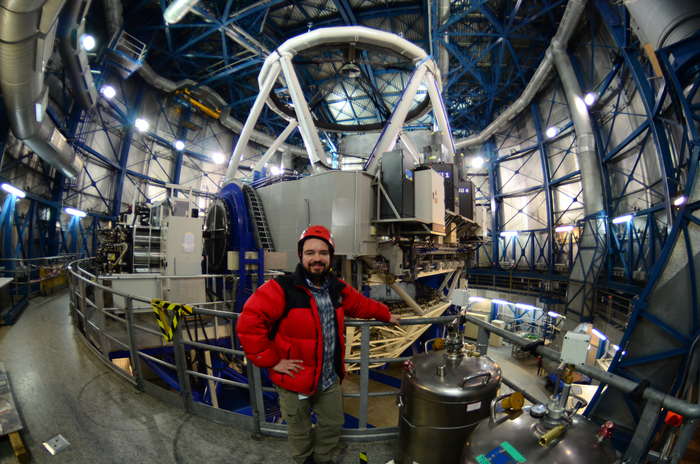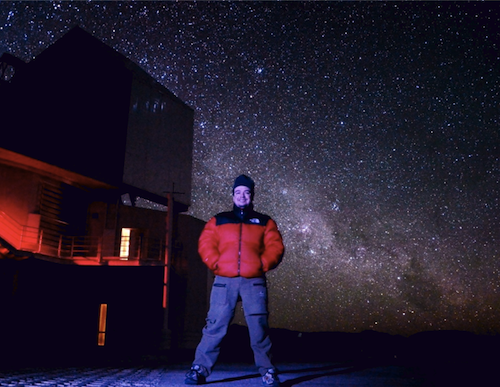
RESEARCH:
My main scientific interest is understanding how the galaxies and clusters of
galaxies that we observe in the local universe came to being, as
well as their physical properties at different redshifts.
In July 2009, I became a faculty member of the
Department of
Astronomy of the Universidad de
Concepción (UdeC) in Chile, where I established the
"Galaxy and Large
Scale Structure evolution" (GaLSSev)
research group
dedicated to the study of clusters of galaxies and their
connection with the evolution of galaxies. Since then, this effort
has been supported by grants from the FONDECYT (regular
category) program of CONICYT, the ALMA fund
from CONICYT,
and the Joint Committee European Southern Observatory
(ESO)-Government of Chile, as well as funding provided by the
BASAL Center "Centro de Astrofísica y
Tecnologías Afines" (CATA), and UdeC. Over the years, I
have gained direct observational experience with facilities such
as the VLT, Magellan, Gemini, APEX, and CTIO Blanco telescopes,
among others.
A bit of history:
As an undergraduate student at
the Department
of Astronomy and Astrophysics of PUC, I studied the collapse and
formation of structures in the universe, focusing, in particular,
on self-similar solutions for the spherical collapse of gas in
an Einstein-de Sitter universe (Advisor: Dr. Andreas
Reisenegger. See:
dissertation).
My Ph.D. research, carried out at
the Institut
d'Astrophysique de Paris (IAP) and the European Southern Observatory (ESO)
in Garching, took an observational approach instead, dedicated to
the study of the physical properties of baryons
in nearby
and distant clusters of
galaxies (Advisors: Dr. Florence Durret [IAP] and Dr. Piero
Rosati [ESO]. See: Ph.D. dissertation).
At present:
Currently, my main research is dedicated to the
analysis and interpretation of imaging and spectroscopic data sets
from ground- and space-based observatories to investigate structure
formation and evolution. In particular, the analysis of
spectroscopic data allows me to map out large-scale structures
(groups and clusters),
study galaxy cluster dynamics and characterize the stellar content
of galaxies in and around high-density environments out to z~1-2. In combination with accurate photometry
and high angular resolution data, it is possible to investigate
the stellar mass assembly history of galaxies
and the effects of the environment on galaxy properties.
As a member of the SpARCS
(PI.: G. Wilson), GCLASS (PI: A. Muzzin), and GOGREEN (PI.: M. Balogh)
collaborations, I am involved in the study of galaxy clusters at
z>0.8 and the search for clusters at z>1.5 to investigate the
transition of these structures from protoclusters at z>2 to
massive clusters at z<1, and the quenching of star formation in
galaxies. I am also part of the CLASH-VLT
survey, a VLT Large Program (PI.: P. Rosati) to carry out a
panoramic spectroscopic survey of massive clusters at z=0.2-0.6,
drawn from the sample of the CLASH HST
multi-treasury program (PI.: M. Postman). This project is
intended to probe the structure, mass distrubution and evolution
of clusters, and obtain a census of primordial galaxies to explore
the growth of structures in the early universe. In addition to the
above, since 2019, I am an external collaborator of
the Southern Photometric Local
Universe Survey (S-PLUS; PI: Claudia Mendes de Oliveira),
where I focus on galaxy properties and quenching in nearby
clusters. And since 2021, I am a member of the 4MOST Science Team
within the Chilean Cluster Galaxy Evolution Survey
(CHANCES; PI: Chris Haines). This survey is intended to obtain ~300.000 spectra of
galaxies in 150 clusters to study, among other interesting
subjects, the pre-processing of galaxies that are incorporated
into the cluster environment from large clustercentric distances.
Last but not least, I participate in the Galaxies Science
Collaboration of the Legacy Survey of Space and Time
(LSST) with the Simonyi Survey Telescope at the Vera Rubin
Observatory, and in the data-science group (PI:
Prof. G. Cabrera-Vives) of the Department of Computer Engineering
at UdeC, specifically in the subgroup of Astroinformatics. I am also
associate researcher of the Area-3 (Galaxies) of
the Center for Astrophysics
and Associated Technologies (CATA; PI: Prof. G. Garay).
• Publications: Refereed & Proceedings
| LSST
Galaxy Roadmap
• Projects:
CLASH-VLT
|
GOGREEN | SpARCS/GCLASS |
CHANCES
—
HCS |
GCP
• Collaborations:
GaLSSev |
S-PLUS |
LSST Galaxies
SC |
4MOST |
Astroinformatics |
MPE/UdeC
• Student projects: if you are
looking for a research project to develop, please check the
GaLSSev page
for topics available or contact me directly.
People:
At present, I work directly with a few students from UdeC (see
below). My group
(GaLSSev) is part of a bigger research environment within our
Department of Astronomy including professors Neil Nagar,
Rodrigo
Herrera-Camus, and Nathan
Leigh. With them and their postdocs and students, we form the
larger Extragalactic Astronomy Group at UdeC, including topics on
AGN physics, sub-millimeter galaxies and radioastronomy, in
addition to those mentioned above. I am also involved with
Profs. Guillermo Cabrera-Vives
and Pierluigi
Cerulo, from the Department of Computer Science at UdeC, in
research projects combining advanced computational techniques and
large astronomical data sets to study galaxy formation and
evolution.
My collaborators outside UdeC include: Prof. Michael Balogh
(Univ. of Waterloo), Prof. Scott Fisher (Univ. of Oregon),
Dr. Hector Flores (Obs. of Paris), Prof. Raphael Gobat (PUCV), Prof. Facundo Gómez
(Univ. de La Serena), Prof. Lucia Guaita (UNAB), Prof. Chris
Haines (Univ. de Atacama), Prof. Yara Jaffé (UV), Dr. Patricio Lagos (Univ. of
Porto), Prof. Chris Lidman (ANU/Siding Spring Obs.), Prof. Claudia
Mendes de Oliveira (Univ. of Sao Paulo), Dr. Hugo Messias (ALMA),
Prof. Julie Nantais (UNAB), Dr. Mario Nonino (Obs. of Trieste),
Dr. Priscilla Nowajewski (ALMA), Prof. Daniela Olave-Rojas
(Univ. of Talca), Dr. Alessandro Rettura (JPL),
Prof. Piero Rosati (Univ. of Ferrara), Prof. Greg Rudnick
(Univ. of Kansas), Prof. James Schombert (Univ. of
Oregon), Dr. Veronica Strazzullo (LMU),
Prof. Sergio Torres (Univ. de La Serena), Dr. Eelco van Kampen
(ESO/ALMA), and
Prof. Gillian Wilson (UC Merced), among others.
Students from UdeC currently working with me (as advisor or co-advisor) are:
• Pablo Astudillo (graduate - master; expected to
graduate: 2023)
• Camila Cid (graduate - master; expected to
graduate: 2023)
• Matías Espinoza (graduate -
master; expected to graduate: 2023)
• Benjamín González (graduate - master; expected
to graduate: 2023)
• Diego Salvador (graduate - master; expected to
graduate: 2023)
• Kamilla Barra (B.S.)
• Jorge Cortés (B.S.)
• Javiera Fuentes (B.S.)
• Iriel González (B.S.)
• Nicolás Henríquez (B.S.)
• Gustavo Iturra (B.S.)
• Felipe Oyarzo (B.S.)
• Antonia Salinas (B.S.)
International students currently working with me are:
• Marcela G. Paillalef (graduate;
Ph.D. student at Obs. of Paris, France)
Postdocs who have previously worked (under my supervision) with me:
• Dr. Julie Nantais (Ph.D. Harvard
University), at UdeC: 2010-2014
Currently assistant professor at Universidad Andrés Bello,
Santiago, Chile
• Dr. Hugo Messias (Ph.D. Lisbon
University), at UdeC: 2011-2013
Currently ALMA DSO Astronomer at ALMA Vitacura, Chile
• Dr. Yun-Kyeong Sheen (Ph.D. Yonsei
University), at UdeC: 2012-2015
Currently staff astronomer at KASI, South Korea
• Dr. Yara Jaffé
(Ph.D. University of Nottingham), at UdeC: 2012-2015
Currently assistant professor at Universidad de
Valparaíso, Valparaíso, Chile
• Dr. Pierluigi
Cerulo (Ph.D. Swinburne University), at UdeC: 2015-2020
Currently assistant professor at the Computer
Science Dept., Univ. de Concepción, Concepción,
Chile
• Dr. Clément Martinache (Ph.D. Paris
University), at UdeC: 2017-2020
Currently out of astronomy

|
|
Left: posing during a long integration observation with the Magellan/Baade telescope at the Las Campanas Observatory in the Chilean Andes (© Alessandro Rettura & R. Demarco). Right: me at the control room of the Magellan/Baade telescope observing clusters of galaxies in the near infrared with the FourStar instrument (© Pierluigi Cerulo).



